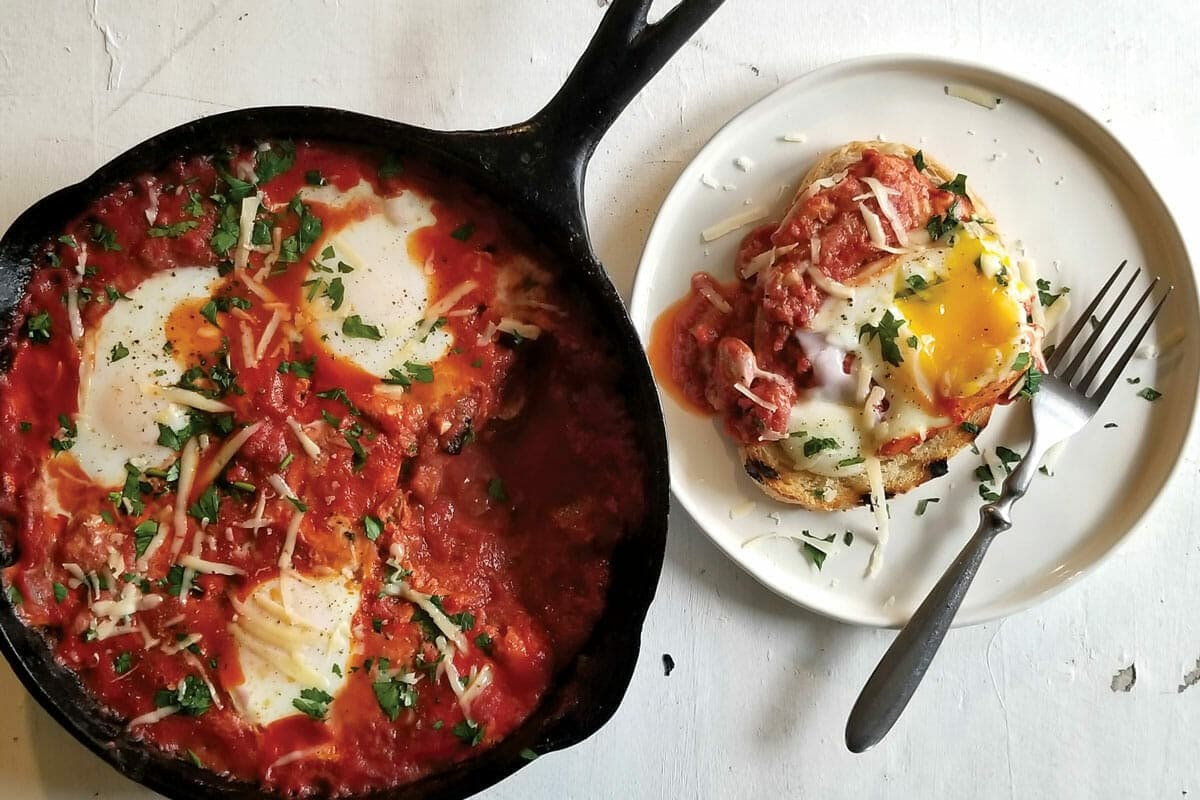
By June Naylor
Photos by Meda Kessler
Hands down, the cast-iron skillet is the most versatile piece of equipment in any cook’s arsenal. It’s really the only pan you need, whether your recipe calls for sauteing, searing, grilling, braising, frying or baking. Properly seasoned, it’s a snap to clean. For the ease of a one-pan dinner, a cast-iron skillet is perfect for chicken potpie, paella, pizza and jambalaya. For dessert, think apple crisp, blackberry cobbler, bread pudding and any kind of upside-down cake. A brunch favorite that also makes a fine Sunday-night supper is Eggs in Purgatory, a dish that adapts easily to a variety of flavor profiles — from Italian (featured here) to a chile-studded Mexican take — with just a few changes in spices, herbs and vegetables. It works beautifully in the cast-iron skillet because the heavy pan (this recipe calls for an 8-inch one) allows you to create a thick tomato sauce that acts as a hot, bubbling cushion in which the eggs are suspended to cook. What’s more, the skillet moves simply from stovetop to oven to table. Serve for brunch with a side of grapefruit brulee or a bowl of fresh fruit with whipped cream; for an evening meal, toss a butter lettuce salad with baby tomatoes, green onion and an herbed vinaigrette as your side.
Is there a difference between enameled cast iron and the plain stuff?
The luxury brands such as French-made Le Creuset are pricier, but Lodge also makes an enamel version. With the enameled pans, the cast-iron cooking surface is actually smooth porcelain, which can be chipped if hit very hard. But it’s also resistant to acidic foods such as tomatoes and citrus. With regular cast iron, the skillet should be well-seasoned to avoid a metallic taste when cooking anything with high acidity. Enameled pots do not require seasoning and need less care when cleaning.
Can you ruin cast iron?
Avoid steel wool and other abrasive material as well as gritty cleaning aids such as Comet. A bit of dishwashing liquid helps when it comes to a really greasy pan, but the pan should be rinsed well, dried thoroughly (heating on the stove works best) and rubbed lightly with cooking oil. If the pan does rust, strip and reseason to bring it back to life.
Eggs in Purgatory
Serves 2
- 3 strips thick-cut smoky bacon, cut into ½-inch pieces
- ½ cup chopped yellow onion
- ½ cup chopped green pepper
- 3 minced garlic cloves
- 1 (28-ounce) can San Marzano tomatoes, pureed with juice
- 2 tablespoons tomato paste
- ½ cup dry red wine
- 6 button mushrooms, sliced
- ½ to 1 teaspoon crushed red pepper flakes
- 2 teaspoons fresh thyme leaves
- 1 teaspoon chopped fresh oregano
- Sea salt and coarse black pepper to taste
- 4 large eggs
- 4 thick slices rustic Italian or sourdough bread
- 1 tablespoon extra-virgin olive oil
- 1/3 cup shaved Parmesan
- Handful chopped fresh parsley
Directions
Heat oven to 425 degrees. In an 8-inch cast-iron skillet over medium-high heat, cook bacon for 5 minutes.
Add onion, green pepper and garlic, stirring well; cook until onion is translucent, about 3 to 4 minutes.
Add pureed tomatoes, tomato paste and red wine, stirring well; reduce heat to medium-low and simmer 5 minutes.
Add mushrooms, crushed red pepper flakes, thyme, oregano and seasonings, stirring well.
Raise heat to medium and, with back of a large spoon, make 4 indentions in the sauce and crack an egg into each. Cook another minute or two, then transfer the skillet to hot oven. Bake until egg yolks are just beginning to set, about 6 to 8 minutes.
While the eggs finish, brush bread slices with olive oil and grill in a pan over high heat until browned at edges and toasty. Remove skillet from oven and garnish with shaved Parmesan and parsley. Spoon eggs and sauce over grilled bread.
